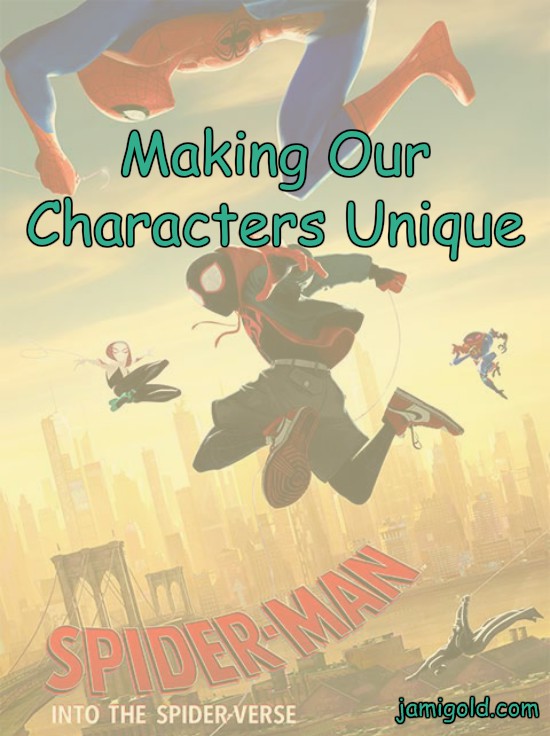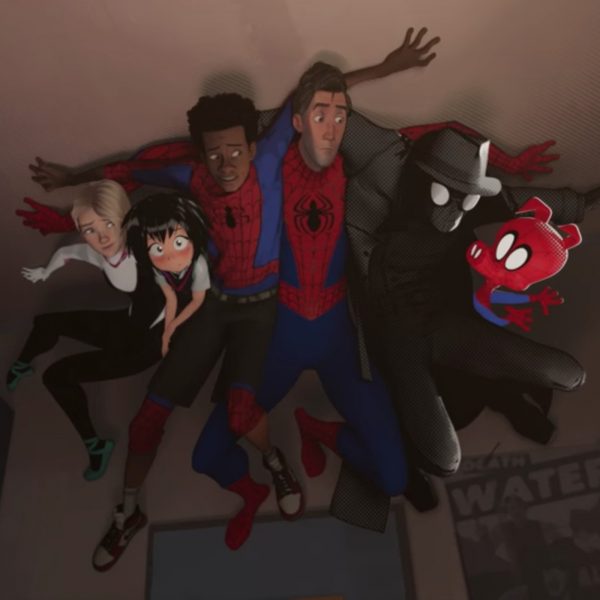Make Characters Unique with Layering

Somewhere along our learning curve as writers, we’re likely to come across the skill of layering. But what does that mean?
Often that skill refers to how we layer in different elements of our story, weaving in our plot, characters, settings, emotions, etc. In fact, some writers even start with just one element—such as writing their whole story just as dialogue—and then layer in everything else once they have the shape of the story.
But today, I want to talk more about layering that focuses on characters. Specifically, I want to dig into how layering can help us create unique characters, no matter how stereotypical or tropey they might be on the surface. *smile*
Recap: What Do We Mean by Layers?
In our story, we might strive to layer in:
- setting, action, and body language information with our dialogue to avoid “talking head” issues
- subtextual information to avoid being too “on the nose” or “spoonfeeding” our readers
- subplots to add complications to the main plot
- character emotions to broaden their reactions from just the obvious (feeling relief and guilt at the same time, etc.)
- theme hints to add a sense of a message and purpose to the story
- conflicting character goals, maybe one a conscious desire and one a subconscious longing that makes it harder for them to make progress
- internal monologue of characters for insight into their thoughts and motivations
- character fears, flaws, and false beliefs to add complications for achieving goals and give them something deeper to overcome
- plot obstacles interfering with characters’ attempts to succeed
- mood-setting information to create style for our story
- rhythm and voice techniques to increase readers’ enjoyment of our words
- etc., etc.
Character Layers within Our Story
Several of the elements above apply to our characters:
- character emotions
- character goals
- internal monologue
- character fears, flaws, and false beliefs
- action and body language: can reveal more about our characters
- subtextual information: can hint at facets of our characters
- subplots/theme hints: often tie into characters’ internal goals or emotional journeys
As we’ve talked about before, we can create three-dimensional characters by showing both external (action, body language, subplots, external goals) and internal (emotions, internal goals, internal monologue, fears, flaws, false beliefs) aspects. But there’s more we can do with character-focused layers beyond just ensuring that we’re balancing different types of narrative and storytelling.
What Are Character-Focused Layers?
Beyond those elements mentioned above, other layers can help define our characters and make them unique:
- appearance (and choices related to appearance: clothing/hair styles, fitness level, etc.)
- personality and worldview (pessimist vs. optimist, sense of humor, dedication to choices/causes, etc.)
- genre/style (what type of world do they inhabit?)
- voice (chatty, curt, morose, self-deprecating, cynical, snarky, etc.)
- habits and quirks
- how they interact with others
- tropes that apply to them or their life (single girl in the big city, hometown hero, etc.)
- causes of stress in their life—and how stress affects them
- coping skills and mechanisms
- level of connectedness to others
- priorities (beyond story goals, what do they care about?)
- internal conflicts and struggles
- how their backstory wound and/or false belief affects them in the here-and-now
- motivations (what drives them and what path does that drive take?)
- choices in the face of conflicts/obstacles/dilemmas
- etc., etc.
Why Do We Want to Use Layers?
Part 1: Add Realism to Characters
One reason to use layers with our characters is to make them realistic. People are complex and complicated, so our characters should be too.
How can we create realistic and unique characters? Add layers... Click To TweetThat realism can overcome the limitations of their stereotypical or “tropey” aspects. Surprisingly, avoiding all stereotypes, clichés, or tropes with our characters isn’t our goal, as those characters wouldn’t feel realistic because we all embody at least one stereotypical aspect (such as my love of chocolate *smile*). Instead, we want to add layers to make them more three-dimensional beyond their stereotypical traits.
Layers can also add meaning to our characters, to make their lives feel deeper than just what’s on the page. For example, with layers, a tropey Navy SEAL might also be:
- a big brother to an adoring little sister,
- a dog owner,
- worried about an upcoming chance for promotion that’s come down to him and his best friend, and
- six months behind on his rent.
If we do our job right when writing a character and keeping their characterization consistent, the different types of layers interact, and those interactions play out in subtext. All that subtext says even more about our character, leading to the impression of a character who’s more than the sum of their parts.
If we don’t do our job right, and those layers don’t interact in the subtext or reveal consistent characterization, we’ll end up with a non-realistic puppet or characters that feel too derivative. Back when the big debate in the publishing world was about charging for worked-over fan fiction stories, some fanfic writers didn’t understand why their changes didn’t erase the plagiarism issue, but as we’ll get into in the next section, a character’s essence goes deeper.
Why Do We Want to Use Layers?
Part 2: Make Characters Unique
Beyond realism, there’s another benefit of using layers with our characters. Like with the example of the Navy SEAL above, adding layers to our characters creates something unique. Sure, there are lots of Navy SEAL characters, but there aren’t any others with an identical mix of layers.
A fantastic example of how changes to layers can make a character feel unique—or at least distinct, even if still derivative—is the recent movie release Spider-Man: Into the Spider-Verse. (Don’t worry, I’ll avoid spoilers. But it’s an enjoyable, groundbreaking film in many ways (the animation is like a full-motion comic book!), so you should see it. *grin*)
In Spider-Verse, the bad guy creates rifts between parallel universes, and various spider-characters from different multiverse versions of the world end up stuck in the version with main character Miles Morales. So the Spider-Man People Characters have to work together to save all the realities.
In other words, there are a total of seven versions of the well-known Spider-Man character in the movie. (Warning: Spoilers at that link.) Well, technically, there are nine Spideys in the movie, but two aren’t well-developed enough to be seen as distinct. *smile*
What Makes a Character Unique?
A Closer Look at Spider-Man: Into the Spider-Verse
The movie goes out of its way to point out how the Spidey characters are all based on the same character essence. They all repeat similar origin stories (“I was bitten by a radioactive…”), have similar backstory wounds (death of Uncle Ben/Uncle Benjamin/etc.), and so on.
What does it take to make a unique character? Maybe not as much as you think... Click To TweetAs they each give their introduction, similar wording and graphic elements are used. Sometimes, the movie even has them speaking in sync, emphasizing the echoes.
Yet despite all that, each of the Spidey characters is unique and distinct in the movie. They don’t feel like clones in the slightest.
The animators drew some of the characters in different animation/comic book styles: anime for Peni Parker, cartoony for Spider-Ham, and black-and-white with dot-shading for Spider-Man Noir, for example. But they have different personalities, worldviews, compassion levels, voice styles, etc. as well.
They each come from a different “world,” a different universe (or even genre), that shaped them and their attitude. They made different choices, had different reactions, had slightly different priorities or enthusiasm, etc.
The dialogue of Noir’s character wouldn’t be said by any other character. The jokes that Spider-Ham makes wouldn’t be made by any other character. The advice from Peter B. Parker fit that character’s role and no other. And so on.
The Same But Different…
In other words, they had different layers. Different styles of interaction, connectedness, coping skills, struggles, etc. Those bullet points mentioned above were slightly tweaked for each one, and those slightly tweaked layers—with consistent characterization and subtext—were enough to make them each distinct.
One character essence. Seven unique and distinct characters. That’s what layering can do for us. *smile*
Have you ever read a character that felt too stereotypical or formulaic? Did they lack layers? Have you struggled to make a character unique? Or if you’ve read a character that felt unique despite their tropes, what created that sense? Can you think of other examples of character layers? If you’ve seen Spider-Verse, do you have any other insights?
Pin It

Fascinating stuff, Jami! How would you define a character essence, exactly? I know you mentioned backstory wound and origin story as part of the essence, but what is a “character essence” precisely?
Also, I liked the example you gave of the Navy SEAL. I reread your old post, and I find that I have a deeper understanding of the layers interacting and conflicting with each other now, since I’ve become a much more experienced writer than I was two years ago.
Hi Sieran,
I’m writing about this “character essence” question in tomorrow’s post. 🙂 Thanks for the idea!
Oh, yay!
The multiverse plot point is always a good exercise for layering, and that’s why it’s so fascinating. Different circumstances that shaped different decisions, which makes different scenarios, all made by the ‘same’ person.
Hi Somebodylost,
Yes! Exactly. 🙂
[…] Make Characters Unique with Layering by Jami Gold […]
This is interesting information. So far, I have written 4 non-fiction books, I have had in mind to write a novel. This post will help me in the future project. Thank you.
[…] Benedict looks into creating characters: you can always start with the car, and Jami Gold suggests making characters unique with layering, while Kristin Lamb says secret-keepers generate page-turning, nerve-shredding […]
I love using the inner monologue, it fleshes out the main character and adds layers. It also accentuates the point of view since I usually write fiction in the limited third person.
Very through article.